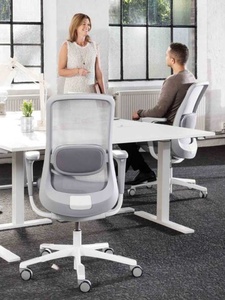Be more proactive with your health in the workplace to ensure increased productivity and improved longevity.
The nature of how Dental professionals work means that sitting for long days is necessary. Working on tedious tasks for hours on end is a requirement. However, sitting slouched or in a poor posture for the majority of the day or adopting habits that raise the likelihood of injury is negotiable. Although a very physically demanding field, Dentists, Dental Nurses and Dental Hygienists shouldn't be doomed to a shortened career riddled with injuries and physical issues. Fortunately there are precautions that can be taken to minimize the risk of back injuries.
Try these simple yet effective tips to improve your ability to work pain free!
1) Employ Active Sitting
Sitting properly means sitting actively and upright with your chest pushed out and minimal static stress on your muscles. Set your saddle at the correct height and adopt a comfortable, relaxed posture which allows a perpendicular gaze over your patient. If needed, tilt the patient’s head to get a direct view into the mouth, don’t over extend to get this view. Saddles that promote mobility and flexibility are a great idea for those looking to prevent any issues arising further down the line. The improved range of movement will allow for better performance at work along with reduced risk of back injuries. Staying in a static tensed posture for extended periods will result in an increased likelihood of injury. At KOS Ergonomics we always say ‘Your next position is your best position’ so try to move as much as possible during treatments. The Balance mechanism on the Amaze and Hopper Dental Saddles helps achieve this variety of movement.
2) Tilt your Pelvis for Optimal Back Posture
The angle between your upper body and thigh (this is the hip angle) should be at least 110 degrees, so that your pelvis is tilted forward. The tilting of your pelvis in this way means your spine retains most of the natural S-shape which is vital in maintaining a healthy posture and spine. A conscious attempt to develop a habit of adopting an improved hip angle can have dramatic results long term on overall posture and back health.
3) Exercise Regularly
Pain and soreness can often be attributed to muscle weakness. Research has indicated that maintenance of a regular exercise regimen will help to reduce back pain. When sitting for long periods in a forward leaning position it is vital to have sufficient core strength to support the lumbar spine. Some form of resistance training a couple of times each week where there is progression within the training program as your own strength increases is an excellent option to improve your posture.
4) Turn Don’t Twist
Repetitive sideways bending and twisting to grab something like an explorer or a mouth mirror can be highly detrimental to your back health. Using a saddle or stool that moves with you as you turn can help significantly to reduce this damage. If possible move any items you usually have to twist or stretch for closer to you, within arms reach. Exercise will also help to develop your core muscles which can take the strain off your spine when performing one off twisting movements.
5) Don’t Lean Over Excessively
On average heads are heavy (usually weighing around 4.5 kgs). When you lean over or bend forward this weight elevates the strain on your upper back vertebrae along with your shoulder and neck muscles. To avoid back pain, minimizing the amount you bend or lean over is very important! Try to sit closer to your patient and avoid bending your head forward by more than 20 degrees. Saddles with a narrow base will enable Dentists to sit closer to their patients thus reducing the likelihood of leaning over..
6) Use A Lumbar Support
Postural variation is the key to maintaining a healthy spine and good posture. A saddle with a lumbar support enables Dentists to alter between sitting positions and to sit back into the seat safely as they work. The lumbar support is also an excellent option for those with issues currently. Supports can provide aid to areas like the lumbar spine which tends to be a problem area among dentists. Of course prevention is better than cure so it is best to start off with a saddle that incorporates lumbar support and a balance mechanism.
For more information regarding workplace ergonomics among dentists or to arrange a Free Consultation with one of our Ergonomic Consultants at our Dublin City Centre Showroom (3 Clare Street Near Merrion Square, opposite the National Art Gallery) get in touch on 01 6110200.















